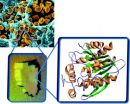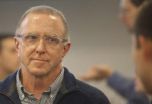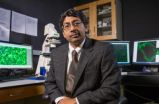(Press-News.org) One of the largest surveys of American views on religion and science suggests that the religious and scientific communities may be less combative than is commonly portrayed in the media and in politics.
Only 27 percent of those surveyed said that they viewed science and religion as being in conflict with each other, with about equal percentages of those people "siding with either religion or science," said Rice University sociologist Elaine Howard Ecklund at the AAAS Annual Meeting. The survey was commissioned by the AAAS Dialogue on Science, Ethics and Religion (DoSER) project and presented at the meeting on 16 February.
Perhaps more importantly, given the large population of evangelical Christians in the United States (up to 30 percent by some estimates), nearly half of the evangelicals surveyed said they felt that science and religion were in a collaborative relationship.
But there are still some significant differences among those surveyed, said Ecklund, who also serves as director of Rice's Religion and Public Life Program. For instance, she noted, evangelicals "were more than twice as likely as the rest of the sample to say that they would turn to a religious leader or text if they have a question about science." The survey also found that 43 percent of evangelicals supported a strong creationist view in which "God created the Earth, the universe and all life within the past 10,000 years."
More than a third of all respondents in the survey agreed that "scientists should be open to considering miracles in their theories or explanations."
The study included over 10,000 people who took a 25-minute survey online, along with 300 personal interviews with Christians, Jews and Muslims. About 5 percent of those surveyed identified themselves as scientists.
DoSER commissioned the survey as the start of a far-ranging project to bring together scientific and religious communities into a more fruitful partnership, less burdened by misconceptions of each other's views, said DoSER Director Jennifer Wiseman.
"Previously, studies have focused on what various groups think about a particular issue involving science, such as evolution or climate change...but this survey is different because it's asking where people look to for authoritative information on science, who do they trust as their authority figures, and how important do they think scientific issues are in their daily life," Wiseman said.
DoSER's advisory committee requested that the project contain a particular focus on evangelicals, "who are typically very interested in national policy and in science and technology, but are significantly underrepresented in the sciences themselves," Wiseman noted.
Galen Carey, vice president for government relations at the National Association of Evangelicals in Washington, D.C., said that he was pleased with the survey's findings. "There is quite a bit of scope for both of our communities to learn more about the other, to combat some of the ignorance which we see, which sometimes gets in the way of collaboration."
After the survey results have been thoroughly analyzed, DoSER will hold a series of regional workshops with leaders from local science communities and evangelical leaders to discuss improving communication between the two groups. They also plan a national conference in 2015 that builds off the issues discussed in the regional workshops.
Another session at the AAAS Annual Meeting discussed public opinions on science and technology as gauged through surveys by the US National Science Board, the Pew Research Center, and the polling company Gallup.
The NSB 2014 Science Indicators study, released earlier this month, found that roughly seven in 10 Americans believe that the effects of scientific research are more positive than negative for society -- a number that has remained roughly the same since 1979.
Other recent surveys show a partisan political gap, however, in views on scientific topics such as evolution and climate change.
Between 2009 and 2013, the gap between Republicans and Democrats on the question of evolution grew by 11 percentage points, said Cary Funk of the Pew Research Center. "There had been a partisan gap before, but the size of the gap is now bigger. And what happened is that fewer Republicans said humans and other living things evolved over time."
Recent polling on climate change science reveals a similar kind of gap, said Gallup researcher Lydia Saad. "What we've seen in the last ten years is a polarization of views, with Democrats clearly becoming more supportive of climate science and Republicans less supportive."
"With the politicalization and debate about this in Washington, we have a situation where some Americans are skeptical of scientists and believe that scientists are now partisan or the science is affected by the politics," Saad added.
INFORMATION: END
Religious and scientific communities may be less combative than commonly portrayed
2014-02-17
ELSE PRESS RELEASES FROM THIS DATE:
Uncovering the secrets of tularemia, the 'rabbit fever'
2014-02-17
WASHINGTON D.C. Feb. 16, 2014 -- Tularemia, aka "rabbit fever," is endemic in the northeastern United States, and is considered to be a significant risk to biosecurity -- much like anthrax or smallpox -- because it has already been weaponized in various regions of the world.
At the 58th Annual Biophysical Society Meeting, which takes place Feb. 15-19, 2014, in San Francisco, Calif., Geoffrey K. Feld, a Postdoctoral researcher in the Physical & Life Sciences Directorate at Lawrence Livermore National Laboratory (LLNL), will describe his work to uncover the secrets of the ...
Bacterial superbug protein structure solved
2014-02-17
WASHINGTON D.C. Feb. 16, 2014 -- A research team from Vanderbilt University Medical Center in Nashville, Tenn., is the first to decipher the 3-D structure of a protein that confers antibiotic resistance from one of the most worrisome disease agents: a strain of bacteria called methicillin-resistant Staphylococcus aureus (MRSA), which can cause skin and other infections. The Vanderbilt team's findings may be an important step in combatting the MRSA public health threat over the next 5 to 10 years.
By deciphering the shape of a key S. aureus protein -- an enzyme called ...
Harvesting light, the single-molecule way
2014-02-17
WASHINGTON D.C. Feb. 16, 2014 -- New insights into one of the molecular mechanisms behind light harvesting, the process that enables photosynthetic organisms to thrive, even as weather conditions change from full sunlight to deep cloud cover, will be presented at the 58th Annual Biophysical Society Meeting, taking place in San Francisco from Feb. 15-19.
At the meeting, Hsiang-Yu Yang, a graduate student, and Gabriela Schlau-Cohen, a postdoc in W.E. Moerner's research group at Stanford University, will describe how probing these natural systems at the single molecule level ...
Deep ocean needs policy, stewardship where it never existed
2014-02-17
BEAUFORT, N.C. -- Technological advances have made the extraction of deep sea mineral and precious metal deposits feasible, and the dwindling supply of land-based materials creates compelling economic incentives for deep sea industrialization. But at what cost?
“We’re really in the dark when it comes to the ecology of the deep sea," said Linwood Pendleton, director of the Ocean and Coastal Policy Program at the Nicholas Institute for Environmental Policy Solutions at Duke University. "We know a lot about a few places, but nobody is dealing with the deep sea as a whole, ...
Obesity in Samoa: A global harbinger?
2014-02-17
PROVIDENCE, R.I. [Brown University] — The South Pacific archipelago of Samoa and American Samoa harbors a global health mystery that may seem both remote and extreme but could foretell trends in obesity and related conditions across much of the developing world.
About three-quarters of the U.S. territory's adult population is obese, the highest rate in the world with independent Samoa quickly catching up. Rates of type 2 diabetes top one in five and a recent study found that the elevated obesity rates are present even in newborns.
This pandemic began only a few decades ...
Global perspectives on human biology and health
2014-02-17
CHICAGO --- Three anthropology professors from the Weinberg College of Arts and Sciences at Northwestern University will highlight recent research in biological anthropology Sunday, Feb. 16 at the annual meeting of the American Association for the Advancement of Science (AAAS) in Chicago.
The presentations, part of the symposium "Comparative Advantage: Global Perspectives on Human Biology and Health" will be held from 1:30 to 4:30 p.m. in Crystal Ballroom A at the Hyatt Regency Chicago.
Christopher Kuzawa, professor of anthropology and faculty fellow at the Institute ...
Nanoelectronics key to advances in renewable energy
2014-02-17
TEMPE, Ariz. – Nanoscale technology looks promising as a major contributor to advancements needed to fulfill the potential of emerging sources of clean, renewable energy.
Progress in the comparatively new area of nanoelectronics in particular could be the basis for new manufacturing processes and devices to make renewable energy systems and technologies more efficient and cost-effective.
Stephen Goodnick will focus on what nanoelectronics advances could do to help push the performance of solar energy systems to the next level in his talk at the 2014 annual meeting of ...
Epigenetic regulation required to ensure correct number of chromosomes
2014-02-17
Abnormal number of chromosomes is often associated with cancer development. In a new study published in the journal Nature Structural and Molecular Biology researchers at Karolinska Institutet in Sweden have shown that a subtle epigenetic change plays an important role in the correct segregation of chromosomes.
Normally when a cell divides, the chromosomes are segregated equally to two daughter cells. However, tumour cells frequently have either too few or too many chromosomes, leading to the incorrect expression of a number of genes. When a cell is about to divide, the ...
New eye layer has possible link to glaucoma
2014-02-17
A new layer in the human cornea — discovered by researchers at The University of Nottingham
last year — plays a vital role in the structure of the tissue that controls the flow of fluid
from the eye, research has shown. The findings, published in a paper in the British
Journal of Ophthalmology, could shed new light on glaucoma, a devastating disease caused by
defective drainage of fluid from the eye and the world's second leading cause of blindness.
The latest research shows that the new layer, dubbed Dua's Layer after the academic Professor
Harminder Dua who ...
Researchers hijack cancer migration mechanism to 'move' brain tumors
2014-02-17
One factor that makes glioblastoma cancers so difficult to treat is that malignant cells from the tumors spread throughout the brain by following nerve fibers and blood vessels to invade new locations. Now, researchers have learned to hijack this migratory mechanism, turning it against the cancer by using a film of nanofibers thinner than human hair to lure tumor cells away.
Instead of invading new areas, the migrating cells latch onto the specially-designed nanofibers and follow them to a location – potentially outside the brain – where they can be captured and killed. ...




